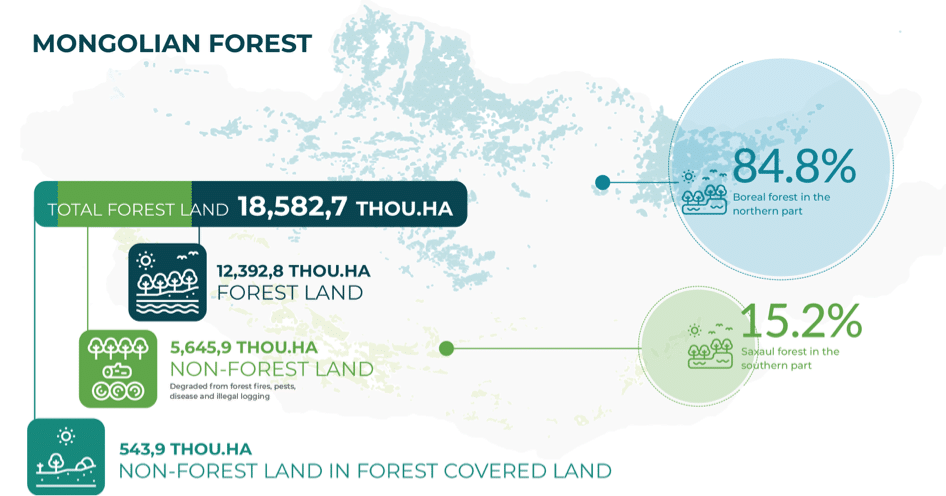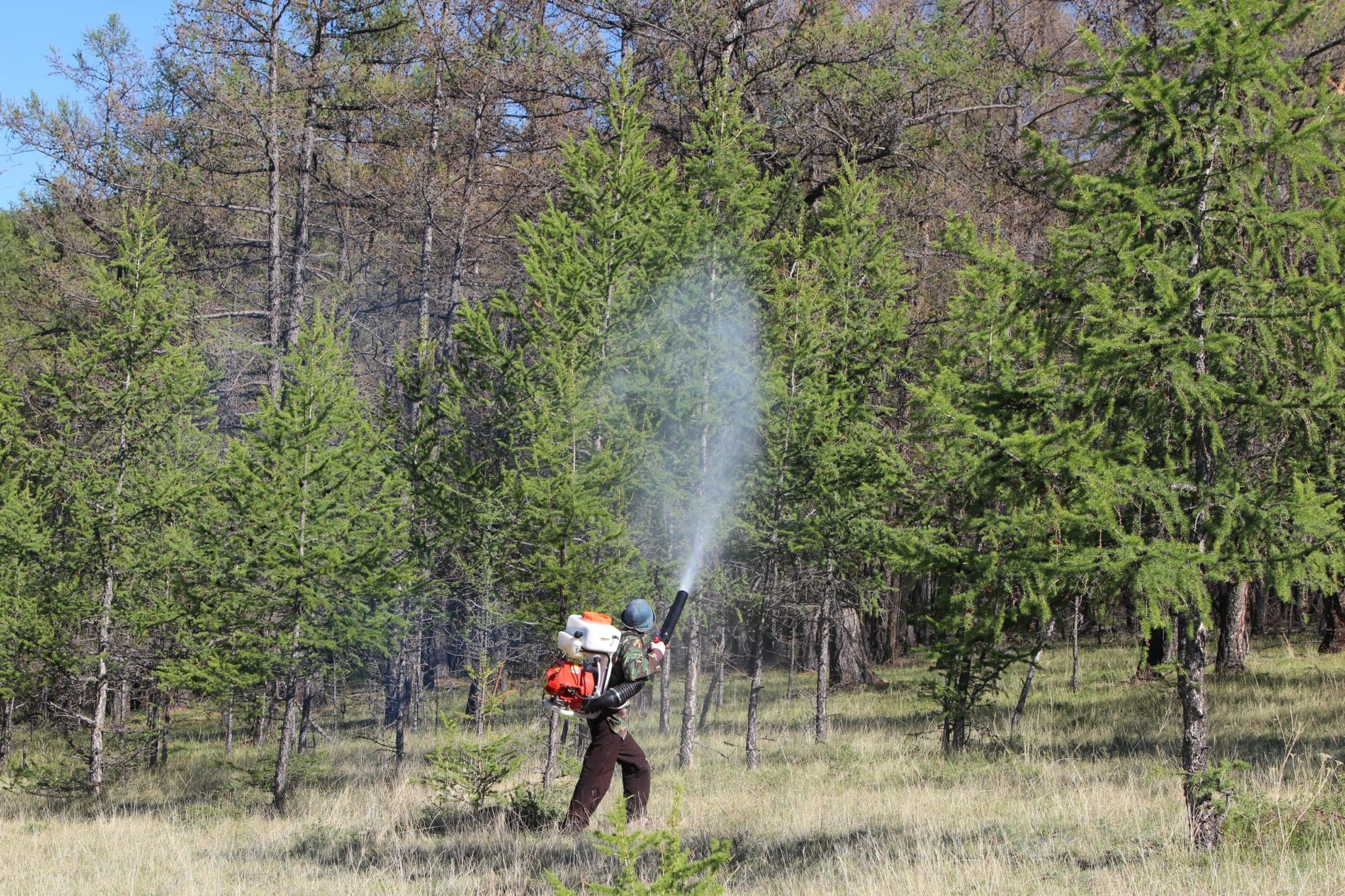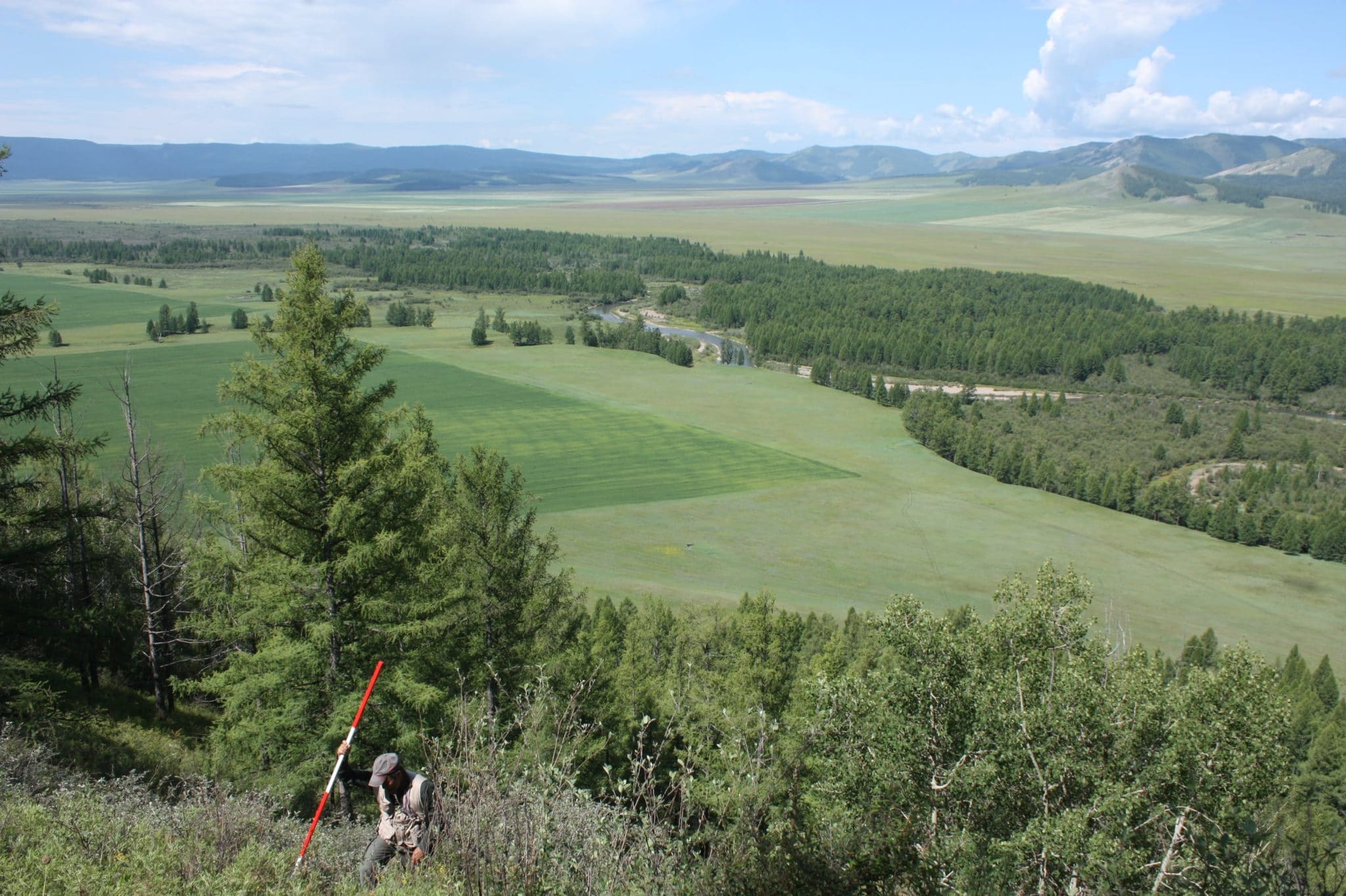1. Background
Mongolia has about 18.6 million ha of forestlands occupying 11.8% of the country’s total land area. Of these, 11,968 ha are fire-prone areas, 1,241 ha are logged-over lands, 9,570 ha are pest-affected areas. Only 12.4 million ha, or 7.85% of the country’s territory, is actually covered by forests. Afforestated areas and naturally regenerated forested areas account for 2,305 ha, which shows the need to formulate and implement a new policy to reduce the degradation and loss of forest resources and restore and conserve forests.

All forest resources in Mongolia are state property. The Ministry of Environment and Tourism of Mongolia provides oversight supervision in terms of overall forest development and conservation, while aimag[1] and soum[2] administrations are responsible for forest management at the local level. Mongolian forest can be divided into two broad types of northern boreal forests and southern saxaul forests. Northern boreal forests, which form an ecological transition zone between the Siberian Taiga and the Central Asian Steppes, account for about 85% of the national forest estate across fourteen aimags. Southern saxual forests are found in the southern Gobi Desert and desert steppe regions. Although they consist of scattered trees and are limited in growth and biomass, southern saxaul forests play an important role in stabilizing arid zone land and reducing desertification.
[1] First-level administrative division (province) in Mongolia. There are 21 aimags.
[2] Second-level administrative division (district) in Mongolia. There are 331 soums.
2. Forest laws, policies, and national action plans in Mongolia
In the Mongolian forestry sector, the following laws, policies, national programs, and action plans are in force as of July 2021:
| No. | Years | Forest-related policies, national programs and action plans |
|---|---|---|
| 4 | 2021-2050 | “Vision-2050” long-term development policy document of Mongolia |
| 5 | 2021-2024 | Action Plan of the Government of Mongolia |
| 6 | 2010-2023 | National Action Plan on Soil Protection and Combat Desertification |
| 7 | 2014-2030 | Green Development Policy |
| 8 | 2015-2025 | National Biodiversity Program |
| No. | Years | Forest-focused policies, national programs and action plans |
|---|---|---|
| 9 | 2015-2030 | State Policy on Forest |
| 10 | 2017-2021 | Medium-Term Action Plan of State Policy on Forest |
| 11 | 2021-2025 | REDD+ National Strategy and Action Plan (brief info HERE) |
| 12 | 2005-2035 | Green Belt National Program |
At the national level, forest strategies and programs are occurring in two different forms. They can be categorized into either forest-related or forest-focused. Forest-related strategies are not mainly oriented to forest issues but originating from other fields of policymaking while forest-focused approaches emanate from documents that are either drafted by actors of the forest sector or those clearly focusing on forest issues.
The main sectoral forest policy document, “State Policy on Forest” of 2015 covers a comprehensive approach in integrating the country’s socio-economic and environmental issues, consistent with the policy on green development, provides guidance for future decisions concerning the conservation, use, and restoration of forest resources for the well being of humans and specifies the goals, principles, and objectives of the forest policy. The policy document, on the other hand, sets the main objectives through an action plan to promote sustainable forest management nationwide. This in a way maintains forest ecosystem balance, halts deforestation and forest degradation, increases forest area through regeneration and afforestation, and ensures proper and sustainable use of forest resources. However, forest conservation remains the priority for the country; aiming to reduce timber harvesting, include as many forest areas as possible in protected areas and conduct reforestation efforts.
Recently, following the revised version of Law on Development Policy, Planning and Management, the Government of Mongolia has initiated the development of a comprehensive environmental targeted program that integrates all policy documents of the environmental sector at the national level. By establishing an integrated system with well-defined objectives, the government aims to avoid the duplication of objectives and activities specified in different medium-term environmental policy documents; improve coordination of regulating mechanisms across different types of policy and planning documents, and strengthen development policymaking and planning as well as their management and structure. Currently, a working group has been assigned at the Ministry of Environment and Tourism to develop the comprehensive integrated environmental policy document.
National Targets that directly support forest restoration and conservation measures, and climate change mitigation efforts include:
- Increase the area of forest cover to 9% of the country’s total territory by 2030;
- The average area affected by forest fire shall be decreased by 70% in 2030;
- Forest pests, threat of disease spread and epicenters shall be fully controlled in 2030;
- Forest ecosystem, biodiversity conservation and protection are improved;
- Greenhouse gas emissions from deforestation and forest degradation shall be reduced by 5% in 2030;
- Forest area from natural regeneration and afforestation shall be increased by 1500 thousand hectares in 2030;
- The rate of usage of primary wooden materials shall be increased up to 80% and fully meet people’s demand for wood and wooden products;
- Food supply and household income shall be increased through the improvement of non-timber forest product use;
- Sustainable forest management shall be introduced to the Mongolian forest sector, qualitative advancement is made in forest conservation, sustainable use and restoration, and ecologically-beneficial healthy forest is established;
- Comprehensively restore 300,000 – 400,000 ha of degraded lands in pastures, mining, forested areas, and agricultural lands.

3. Existing problems
Forestry issues in Mongolia involve several interrelated areas of concerns such as policy, institutional structures, legislation, decentralization, research and extension, human resource development, and inter-sectoral coordination. Organizational structures that define the institutions and/or agencies required for translating policy directions into action on one hand, and the authority for enforcing legislation on the other are constrained to effectively and efficiently implement their respective mandates due to policy conflicts and gaps, lack of qualified staff with technical capacity, institutional fragmentation and lack of clear mandates, and poor coordination. Having a core function in sector management, these issues negatively influence the operational quality and sector development potential. Moreover, the funding currently being provided to the forestry sector is not sufficient to support more effective forest management, especially in consideration of the potential of forestry to support rural livelihoods.
Mongolia’s natural forests are in great need of appropriate silvicultural practices such as tending and thinning to ensure healthy forest stands, increased growth, and resilience to climate change. The depleted forest resource base can also be attributed to the limited resources and institutional capacities on forest management, which increases the risk of forest fires, deforestation, and damage from insect pests. The constraints that inhibit proper forest management include:
- Shortage of financial sources to invest in forests for government, private forest enterprises (PFEs), cooperatives and forest user groups (FUGs) activities;
- Limited technical knowledge and skills;
- Unclear policy and regulatory framework for benefit sharing and livelihood opportunities;
- Insufficient technical skills and capacities at the local level for forest management planning and forest mapping;
- Limited support from local governments to FUGs and PFEs in the implementation of forest management plans;
- Weak cooperation between FUGs and local government organizations in forestry activities;
- Natural resource conflicts over pasture lands in forest areas for management and responsibilities.
As a result, there is limited effective engagement across all levels for forest planning, management, application of good silvicultural practices, law enforcement, and opportunities for improving livelihoods. This showcases that forest management in Mongolia faces numerous challenges, and is in urgent need of integrated and science-based approaches.
4. Policy recommendations
The findings and results of the Multi-Purpose National Forest Inventory (2014–2016) serve as a good basis for the elaboration of future policy directions to achieve sustainable forest management in line with Target 15.2 of the 2030 Agenda for Sustainable Development. The Multi-Purpose National Forest Inventory has revealed that Mongolian boreal forests are largely over mature. Consequently, the country’s forests are not only less productive but also more prone to fires and pest attacks and less resilient to climate change. Moreover, these lead to forest degradation and, ultimately, deforestation. Hence, science-based and aggressive forest management of mature and overmature stands is imperative. This would not only improve overall forest condition but also create jobs and improve incomes in rural areas. Mongolia also needs to develop its national criteria and indicators of sustainable forest management, which are important for it to be able to measure progress towards Target 15.2.
The Inventory also shows that Mongolian boreal forests have restoration potentials. The average tree regeneration (≥150 cm) is 959 stems/ha, showing the potential of forest regeneration in Mongolia. Natural regeneration offers a direct opportunity to manipulate species composition. Thinning and tending offer means to steer the forest succession and promote target species composition, stand stability, quality, and structure, as well as enhancing the growth of timber trees. Because more than 70% of the forest area is occupied by mono-species stand type, more diversified stands need to be further encouraged since forest diversification is key to increase their adaptive capacity, much more than resilient forests will increase future economic and social benefits. Based on the conclusions of the inventory results and policy analysis, recommendations have been developed to enhance coherence and improve the effectiveness of forest management policies and practices in Mongolia. The recommendations are grouped into the following 5 different priority areas:
Priority Area 1. Forestry institutional, governance and financial management
- Conduct an institutional and capacity assessment as the basis for proposing sector reform through a restructuring plan, which will propose to put in place an improved organization setting for human resources, staffing technical skill and capacities, enhance linkage to research and education and training facilities as well as local and central equipment and materials in place;
- Strengthen operations of the inter-soum forest units through provision of equipment and training;
- Make efforts to increase funding for more effective forest management with a consideration of the potential of forestry to support rural livelihoods and create green jobs;
- Define the requirements and prepare a framework for a Forest Management Information System. It will serve as a data repository and function as a decision support system for improved forest resource and sector management;
- Expand and intensify the collaboration with international organizations;
Priority Area 2. Sustainable forest management
- Develop a system of national certification for sustainable forest management and bring it closer to international certification systems, as well as monitor the work of licensed professional forestry organizations and ensure that licenses are issued/renewed to qualified organizations only;
- Conduct a study on the impact of active forest management and use by FUGs to address its impact on deforestation and forest degradation and the resulting carbon benefits through increased stand increment and avoidance of forest fires and other causes of forest degradation, with the support of spatial tools;
- Introduce and adopt technology-based preventive and control measures of forest-related disasters in the targeted aimags, and establish demonstration sites for control and management purposes;
Priority Area 3. Restoration and reforestation
- Initiate customized restoration and reforestation models based on best practices and integrated approaches to reach the national restoration targets in time;
- Adopt and apply such models in a balanced and integrated approach of forest landscape restoration for the benefit of target communities, natural habitats, and forest ecosystem;
- Increase the reforestation in the southern part of the country to mitigate desertification and combat yellow dust storms;
- Prepare professionals in post-management plan after the restoration to evaluate the effectiveness of reforestation and afforestation efforts;
Priority Area 4. Raw materials production, use, and efficiency
- Conduct an economic and sustainability analysis on the possibility of using residues from thinning and tending operations to produce biofuels such as chips, briquettes, pellets and charcoal;
- Develop a concept for supporting small-scale forest enterprises based on forest user groups to create green jobs, provide sustainable wood supply for domestic consumption, heating and cooking and to improve local livelihoods;
- Prepare guidelines for forest and non-timber forest product income generation and livelihood opportunities by describing start-up business model support requirements and financing options. This will include support for starting up, planning for and improving small business operations at the soum level. Business may include forest and non-timber forest products, and nurseries, among others;
Priority area 5. Research, education and awareness-raising
- Implement scientific-based studies on forestry adaptation approaches;
- Forest-related education in sustainable development is very well suited to counter-acting the growing alienation of people not only from forests but from their natural environment in general. It should, therefore, be attributed to greater importance. The responsible, longer-term handling of resources, the principle of sustainability, can be illustrated very well using the example of forest management. Forest administrations and associations continue to show a commitment to environmental forest education and consumer education. Training and information offerings should be posted as comprehensively as possible on the MET website;
- Qualified workers are needed to continue multi-functional forest management. They should be trained in economics, technology, and also in the basics of the natural sciences. They should master the methods and instruments of sustainable management taking into account the diverse range of services of general interest rendered by forests. Lastly, they should implement the latest findings from research and development in practice;
- Suitable offerings need to be developed to provide information and raise awareness amongst forest visitors about the nature they experience and the mode of action and contribution of sustainable forestry. This is a good opportunity for close cooperation between the relevant associations;

The requirements and conception of game-friendly and forest-friendly wild game management should be discussed more by the public at large with all stakeholders. At the same time, they should be further developed as an essential component of hunting training schemes. The local hunting organizations should do more to provide the public at large as well with reliable information and findings.
References:
- Ministry of Environment and Tourism of Mongolia (2017): State Policy on Forest. In The Mongolian Law on Forest, Forest Policy and Green Development Policy., 1st edition. GIZ Programme “Biodiversity and Adaptation of Key Forest Ecosystems to Climate Change II”, 57-94
- United Nations Economic Commission For Europe (2018): Environmental Performance Reviews, Mongolia Synopsis, New York and Geneva, 57.
- Hijaba Ykhanbai (2010): Mongolia Forestry Outlook Study, Working Paper No. APFSOS II/WP/2009/21, Food and Agriculture Organization of the United Nations, Bangkok, Thailand, 49.
- Asian Development Bank (2020): Preparing the Forest Sector Development Program, TA 9899-MON, Ulaanbaatar, Mongolia, 23. (not available online)
- Ministry of Environment and Tourism of Mongolia (2016): Mongolian Multipurpose National Forest Inventory 2014-2016. 1st edition, Ulaanbaatar, Mongolia, 340.
- Weber, Norbert (2017): Participation or involvement? Development of forest strategies on national and sub-national level in Germany. Science Direct, Germany, Forest Policy and Economics 89 (2018), 98-106.
Contributed by Maralgoo Ganbat, 2021 AFoCO Fellowship Official from Mongolia

